The AMD Radeon R9 Fury X Review: Aiming For the Top
by Ryan Smith on July 2, 2015 11:15 AM ESTGrand Theft Auto V
The final game in our review of the R9 Fury X is our most recent addition, Grand Theft Auto V. The latest edition of Rockstar’s venerable series of open world action games, Grand Theft Auto V was originally released to the last-gen consoles back in 2013. However thanks to a rather significant facelift for the current-gen consoles and PCs, along with the ability to greatly turn up rendering distances and add other features like MSAA and more realistic shadows, the end result is a game that is still among the most stressful of our benchmarks when all of its features are turned up. Furthermore, in a move rather uncharacteristic of most open world action games, Grand Theft Auto also includes a very comprehensive benchmark mode, giving us a great chance to look into the performance of an open world action game.
On a quick note about settings, as Grand Theft Auto V doesn't have pre-defined settings tiers, I want to quickly note what settings we're using. For "Very High" quality we have all of the primary graphics settings turned up to their highest setting, with the exception of grass, which is at its own very high setting. Meanwhile 4x MSAA is enabled for direct views and reflections. This setting also involves turning on some of the advanced redering features - the game's long shadows, high resolution shadows, and high definition flight streaming - but it not increasing the view distance any further.
Otherwise for "High" quality we take the same basic settings but turn off all MSAA, which significantly reduces the GPU rendering and VRAM requirements.
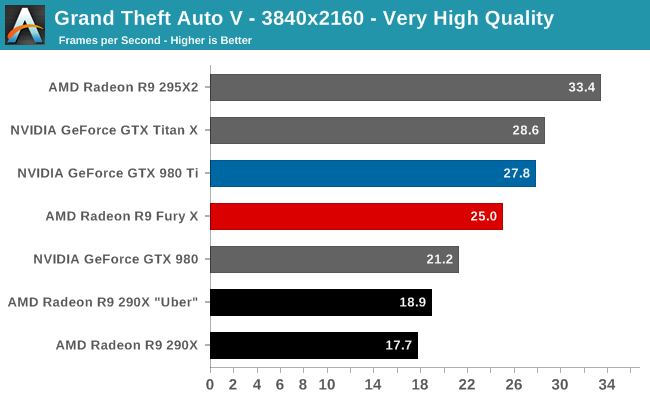
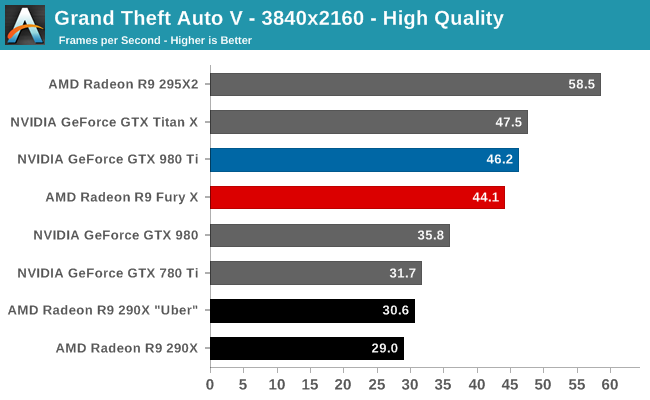
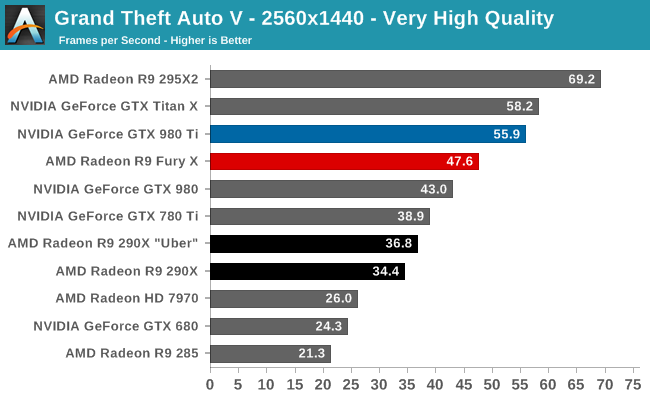
Our final game sees the R9 Fury X go out on either an average or slightly worse than average note, depending on the settings and resolution we are looking at. At our highest 4K settings the R9 Fury X trails the GTX 980 Ti once again, this time by 10%. Worse, at 1440p it’s now 15%. On the other hand if we run at our lower, more playable 4K settings, then the gap is only 5%, roughly in line with the overall average 4K performance gap between the GTX 980 Ti and R9 Fury X.
In this case it’s probably to AMD’s benefit that our highest 4K settings aren’t actually playable on a single GPU card, as the necessary drop in quality gets them closer to NVIDIA’s performance. On the other hand this does reiterate the fact that right now many games will force a tradeoff between resolution and quality if you wish to pursue 4K gaming.
Finally, the performance gains relative to the R9 290X are pretty good. 29% at 1440p, and 44% at the lower quality playable 4K resolution setting.
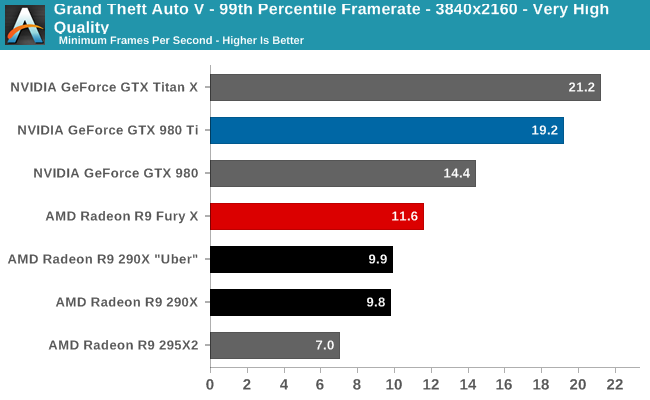
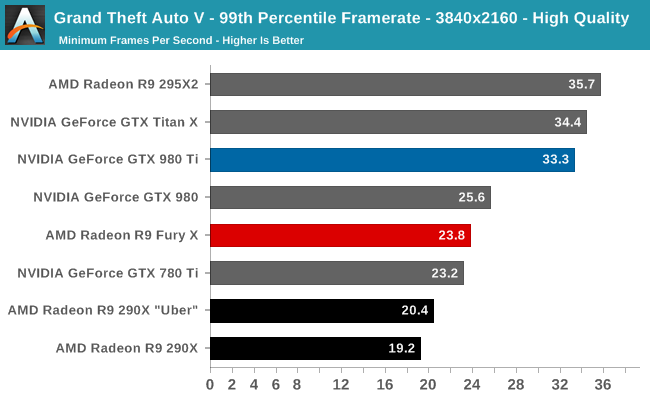
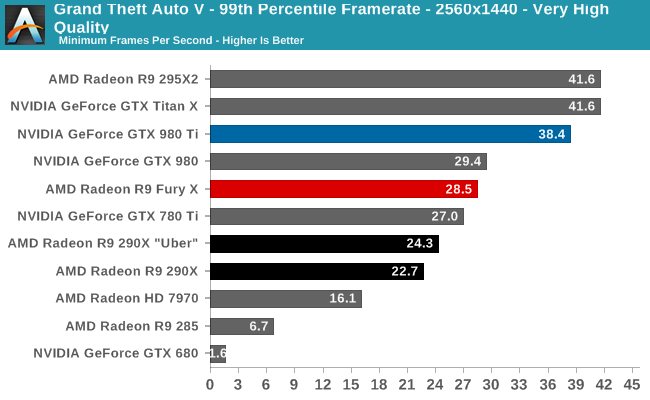
Shifting gears to 99th percentile frametimes however – a much-welcome feature of the game’s built-in benchmark – finds that AMD doesn’t fare nearly as well. At the 99th percentile the R9 Fury X trails the GTX 980 Ti at all times, and significantly so. The deficit is anywhere between 26% at 1440p to 40% at 4K Very High.
What’s happening here is a combination of multiple factors. First and foremost, next to Shadow of Mordor, GTAV is our other VRAM busting game. This, I believe, is why 99th percentile performance dives so hard at 4K Very High for the R9 Fury X, as it only has 4GB of VRAM compared to 6GB on the GTX 980 Ti. But considering where the GTX 980 places – above the R9 Fury X – I also believe there’s more than just VRAM bottlenecking occurring here. The GTX 980 sees at least marginally better framerates with the same size VRAM pool (and a lot less of almost everything else), which leads me to believe that AMD’s drivers may be holding them back here. Certainly the R9 290X comparison lends some possible credit to that, as the 99th percentile gains are under 20%. Regardless, one wouldn’t expect to be VRAM limited at 1440p or 4K without MSAA, especially as this test was not originally designed to bust 4GB cards.










458 Comments
View All Comments
Samus - Saturday, July 4, 2015 - link
Being an NVidia use for 3 generations, I'm finding it hard to ignore this cards value, especially since I've invested $100 each on my last two NVidia cards (including my SLI setup) adding liquid cooling. The brackets alone are $30.Even if this card is less efficient per watt than NVidia's, the difference is negligible when considering kw/$. It's like comparing different brand of LED bulbs, some use 10-20% less energy but the overall value isn't as good because the more efficient ones cost more, don't dim, have a light buzz noise, etc.
After reading this review I find the Fury X more impressive than I otherwise would have.
Alexvrb - Sunday, July 5, 2015 - link
Yeah a lot of reviews painted doom and gloom but the watercooler has to be factored into that price. Noise and system heat removal of the closed loop cooler are really nice. I still think they should launch the vanilla Fury at $499 - if it gets close to the performance of the Fury X they'll have a decent card on their hands. To me though the one I'll be keeping an eye out for is Nano. If they can get something like 80% of the performance at roughly half the power, that would make a lot of sense for more moderately spec'd systems. Regardless of what flavor, I'll be interested to see if third parties will soon launch tools to bump the voltage up and tinker with HBM clocks.chizow - Monday, July 6, 2015 - link
Water cooling if anything has proven to be a negative so far for Fury X with all the concerns of pump whine and in the end where is the actual benefit of water cooling when it still ends up slower than 980Ti with virtually no overclocking headroom?Based on Ryan's review Fury Air we'll most likely see the downsides of leakage on TDP and its also expected to be 7/8th SP/TMU. Fury Nano also appears to be poised as a niche part that will cost as much if not more than Fury X, which is amazing because at 80-85% of Fury X it won't be any faster than the GTX 980 at 1440p and below and right in that same TDP range too. It will have the benefit of form factor but will that be enough to justify a massive premium?
Alexvrb - Monday, July 6, 2015 - link
You can get a bad batch of pumps in any CLC. Cooler Master screwed up (and not for the first time!) but the fixed units seem to be fine and for the units out there with a whine just RMA them. I'm certainly not going to buy one, but I know people that love water cooled components and like the simplicity and warranty of a CL system.Nobody knows the price of the Nano, nor final performance. I think they'd be crazy to price it over $550 even factoring in the form factor - unless someone releases a low-profile model, then they can charge whatever they want for it. We also don't know final performance of Fury compared to Fury X, though I already said they should price it more aggressively. I don't think leakage will be that big of an issue as they'll probably cap thermals. Clocks will vary depending on load but they do on Maxwell too - it's the new norm for stock aircooled graphics cards.
As for overclocking, yeah that was really terrible. Until people are able to tinker with voltage controls and the memory, there's little point. Even then, set some good fan profiles.
Refuge - Thursday, July 23, 2015 - link
To be honest, the wine I've seen on these isn't anything more than any other CLC I've ever seen in the wild.I feel like this was blown a bit out of proportion. Maybe I'm going deaf, maybe I didn't see a real example. I'm not sure.
tritiumosu3 - Thursday, July 2, 2015 - link
"AMD Is nothing if not the perineal underdog"...
perineal =/= perennial! You should probably fix that...
Ryan Smith - Thursday, July 2, 2015 - link
Thanks. Fixed. It was right, and then the spell-checker undid things on me...ddriver - Thursday, July 2, 2015 - link
I'd say after the Hecktor RuiNz fiasco, "perpetual underdog" might be more appropriate.testbug00 - Sunday, July 5, 2015 - link
Er, what fiasco did Hector Ruiz create for AMD?Samus - Monday, July 6, 2015 - link
I'm wondering the same thing. When Hector Ruiz left Motorola, they fell apart, and when he joined AMD, they out-engineered and out-manufactured Intel with quality control parity. I guess the fiasco would be when Hector Ruiz left AMD, because then they fell apart.